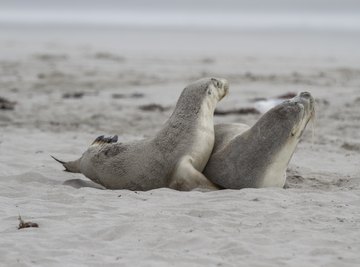
Seals are marine mammals, which means that they spend most of their time in the ocean but breathe like humans and other land animals do (i.e., they have lungs). They have a distinct sort of whiskered face that is often endearing to youngsters and older people alike, and are associated with a particular kind of hooting noise. When they emerge from the water, it is usually to rest, eat, bask in the sun, mate or give birth.
Kids can learn interesting facts about seals in places like Antarctica by watching videos made by marine biologists, or they can take the fun facts about seals they learn in class with them in their heads the next time they visit a zoo close to home.
Marine Mammal Facts
Marine mammals live in the ocean but breathe air. ("Marine" refers specifically to the ocean and excludes freshwater habitats.) They give live birth to live young, nurse their babies and are warm-blooded. Kids can remember that not only are seals mammals, but sea lions, whales, dolphins, porpoises, manatees and sea otters are, too. Fun fact: Polar bears are considered marine mammals thanks to the amount of time they spend in the water.
Basic Seal Facts for Kids
Seals are pinnipeds, meaning "fin-feet." They have two of these in the front and two in the back. Other animals in this family include sea lions and walruses. (Younger kids can be quizzed on why these animals have these instead of regular legs like other mammals.) Although seals look awkward trying to use their fins for locomotion on land, they are surprisingly agile. They can move with deceptive speed despite looking clumsy, and they can even outrun people over short distances. They are covered in a layer of fat called blubber that helps keep them warm in the cold waters and air at high latitudes.
Types of Seals
Kids interested in digging deeper into seal knowledge can investigate a particular species and prepare a basic report. Examples include:
- crabeater seals
- harp seals
- gray seals
- hooded seals
- leopard seals
- monk seals
- Ross seals
- Weddell seals
Gray seals of the Arctic Ocean and northern Atlantic Ocean are a representative type of seal; the adult males are about 7 1/2 feet long and weigh in excess of 750 pounds, about 20 percent bigger than females.
Seals vs. Sea Lions
It is easy to confuse these two animals. Kids can memorize the major differences with relative ease. Sea lions have small external ear flaps, whereas seals only have small ear holes. Sea lions have long front fins and paddle-like rear fins, whereas in seals the two pairs consist of identical fins. Finally, sea lions can rotate their hind flippers to aid in land travel, whereas seals cannot.
References
About the Author
Kevin Beck holds a bachelor's degree in physics with minors in math and chemistry from the University of Vermont. Formerly with ScienceBlogs.com and the editor of "Run Strong," he has written for Runner's World, Men's Fitness, Competitor, and a variety of other publications. More about Kevin and links to his professional work can be found at www.kemibe.com.
